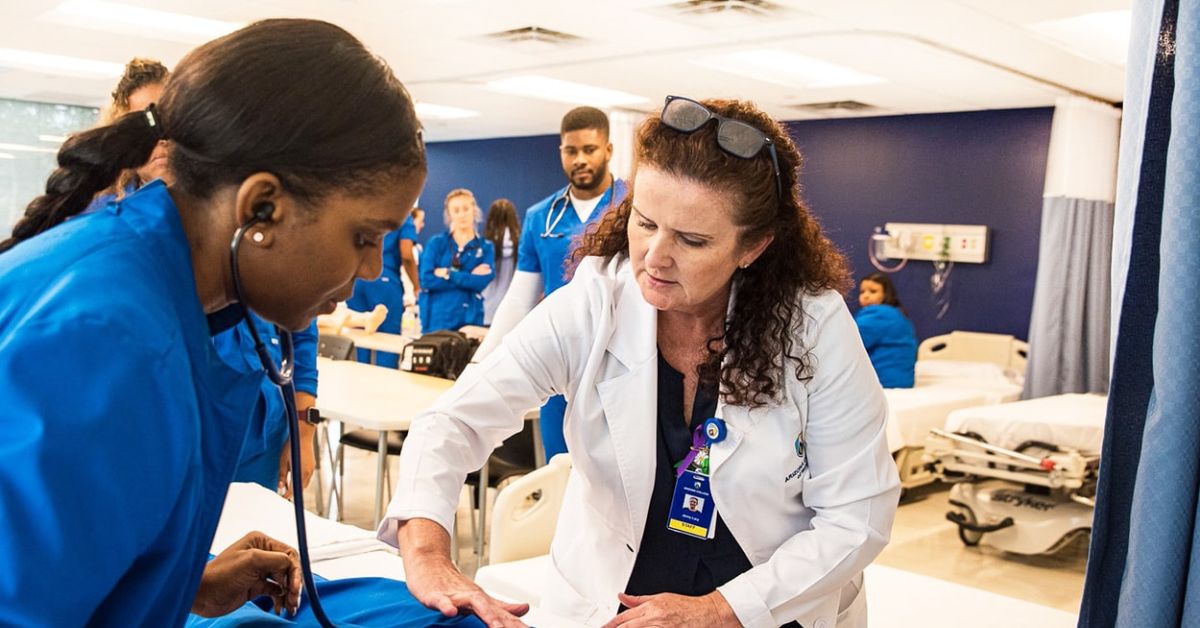Nursing is evolving at record speed, and so are the educational pathways that lead to professional practice. Nursing School in 2025 is no longer confined to textbooks and bedside demonstrations; it blends immersive technology, data‑driven learning, and global health priorities to equip tomorrow’s clinicians with next‑level skills.
Because healthcare shortages persist worldwide, schools have embraced flexible entry routes, intelligent simulation, and outcome‑based assessments that prove competence rather than seat‑time. Students must therefore rethink how they plan, study, and finance their degrees.
In This Article
The Evolving Landscape of Nursing Education in 2025
Digital‑First Curriculum Delivery
Nursing School in 2025 relies on virtual learning environments that integrate interactive lecture capture, adaptive quizzes, and real‑time polling. Cloud‑hosted learning‑management systems track progress minute by minute, allowing faculty to intervene before gaps widen. Students view annotated procedure videos, join breakout rooms, and submit reflective journals directly from their tablets.
Virtual and Augmented Reality Simulation Labs
High‑definition head‑sets now place learners inside fully rendered hospital wards where vital signs, alarms, and patient dialogue feel authentic. Unlike static manikins of the past, VR patients can bleed, sweat, and speak multiple languages. Faculty adjust scenarios in real time, challenging clinical reasoning in a safe, repeatable environment that reduces costly in‑person lab hours.
Competency‑Based Assessment and Personalised Learning Paths
Seat‑time is out; demonstrable competence is in. Digital badges confirm mastery of pharmacology calculations, wound care, or advanced cardiac life support. Algorithms build individual study plans, recommending micro‑modules or peer‑coaching based on performance analytics. Graduates showcase an electronic skills passport to employers, accelerating onboarding.
Interprofessional Education and Collaborative Care
Complex patient needs demand cohesive teamwork. Nursing School in 2025 schedules cross‑disciplinary case conferences with pharmacy, physiotherapy, social work, and IT students. Collaborative electronic records let teams co‑create care maps, mirroring today’s integrated delivery systems.
Focus on Mental Health, Resilience, and Cultural Safety
Burnout prevention is embedded from day one. Mindfulness labs, peer‑support circles, and trauma‑informed pedagogy help students develop coping strategies. Courses on cultural humility and Indigenous health equity ensure graduates deliver safe, respectful care to diverse populations.
Integration of AI, Big Data, and Genomics
From automated triage chat‑bots to predictive analytics that flag sepsis risk, artificial intelligence is standard content. Learners evaluate algorithmic bias, interpret genomic test results, and apply data visualisation in quality‑improvement projects. Graduates speak the language of precision health as naturally as pathophysiology.
Sustainability and Planetary Health Content
Climate‑sensitive curricula teach students to manage heat‑related illness, disaster response, and sustainable supply chains. Reflexive waste‑reduction exercises—like calculating emissions saved by telehealth—reinforce ecological stewardship.
Key Policy and Accreditation Updates
The Next‑Generation NCLEX
The Next‑Gen NCLEX, fully deployed by 2025, uses case‑based items that test clinical judgment under time pressure. Question formats include extended drag‑and‑drop, matrix grids, and hotspot images. Schools align formative assessments accordingly, so practice exams mirror licensure realities.
Expanded Advanced Practice Roles
Many jurisdictions now grant nurse practitioners independent prescribing authority for controlled medicines, chronic‑disease management, and diagnostics. Curricula include deeper pharmacotherapeutics, radiology interpretation, and business management to prepare graduates for primary‑care shortages.
Multi‑State Licensure and Compact Expansion
The Nurse Licensure Compact covers more states and provinces than ever, making cross‑border telehealth viable. Programmes incorporate tele‑presence etiquette, jurisdictional documentation rules, and digital privacy law.
Diversity, Equity, and Inclusion Benchmarks
Accreditors evaluate demographic parity between student cohorts and the communities they serve. Holistic admissions, bias training, and equitable remediation plans are mandatory reporting metrics.
Climate‑Resilient Healthcare Standards
New accreditation criteria require instruction on extreme‑weather triage, supply‑chain disruptions, and energy‑efficient clinical design. Students complete sustainability capstones to meet graduation thresholds.
Nursing School Admission in 2025 What’s Different?
- Holistic Review – Committees weigh life experience, multilingual fluency, and community service as heavily as GPA.
- Test‑Optional Routes – Many campuses have dropped standardised exams, replacing them with situational judgment tests that assess empathy and ethics.
- Digital Portfolios – Applicants upload short video reflections, electronic care‑aid certificates, and volunteer logs. Reviewers scan for growth mindset and tech fluency.
- Micro‑Credential Pathways – Candidates can earn stackable, six‑week certificates (e.g., Medical Terminology, Health Informatics) that shorten first‑year coursework and prove motivation.
How to Prepare Academically Before Enrolment?
Strengthen STEM Fundamentals
Refresh biology, chemistry, and statistics through open‑course platforms. Nursing pharmacology now integrates biochemistry pathways for cellular drug uptake, so be ready for molecular diagrams.
Master Digital Literacy
Familiarity with electronic health records, basic coding syntax (SQL or Python), and data dashboards gives you a head start. Enrol in free MOOCs that teach spreadsheet macros and de‑identification methods.
Cultivate Evidence‑Based Thinking
Practice critiquing randomised control trials and systematic reviews. Build a habit of reading clinical‑practice guidelines monthly. Form study groups that debate the strength of evidence.
Practical Skills to Build Now
Clinical Reasoning with Free Simulators
Hundreds of browser‑based apps walk you through paediatric asthma, wound staging, and fluid resuscitation. Record your decision trees to spot error patterns.
Communication and Leadership
Enroll in public‑speaking workshops. Volunteer as a peer mentor at local clinics to refine hand‑off reports, SBAR frameworks, and motivational interviewing.
Self‑Care and Emotional Intelligence
Use reflective journaling to track stress triggers. Practise grounding techniques like square breathing so they feel automatic in code situations.
Intercultural Competence
Travel, volunteer with migrant health charities, or engage in virtual language exchanges. Even basic proficiency in Spanish, Mandarin, or Arabic can set you apart in diverse clinical placements.
Financial Planning and Scholarships
| Expense Category | Typical Range (USD) | Money‑Saving Tips |
|---|---|---|
| Tuition & Fees | $18 000–$45 000/year | Apply early for workforce‑shortage grants, employer‑sponsored study leave, or regional tuition caps. |
| Books & Digital Resources | $1 200–$2 000 | Buy e‑text subscriptions, share licences in cohort bundles. |
| Simulation & Lab Costs | $500–$1 500 | Join peer‑practice clubs that negotiate group discounts. |
| Living Expenses | $12 000–$25 000 | Consider cooperative housing with rotating meal plans. |
| Exam & Licensure Fees | $650–$1 000 | Bundle review‑course vouchers with registration to save admin charges. |
Loan Forgiveness Schemes
Rural hospitals and community clinics often pay 60–100 percent of student loans in exchange for two‑to‑four‑year service contracts. Track application deadlines one year before graduation.
Thriving During Your Programme
- Time Management – Use calendar blocking to allocate simulation prep, reading, and rest.
- Experiential Learning – Volunteer for quality‑improvement pilot projects; they look excellent on resumes and sharpen data skills.
- Networking – Join student chapters of Sigma Theta Tau and specialty interest groups like peri‑operative nursing or informatics.
- Mentorship – Seek alumni mentors through LinkedIn; a 20‑minute call monthly can clarify career trajectories.
- Academic Support – Book faculty office hours early. Peer‑tutoring centres help contextualise complex pathophysiology.
Career Pathways After Graduation in 2025
| Role | Core Functions | Typical Setting | Median Salary (USD) |
|---|---|---|---|
| Telehealth Triage Nurse | Remote symptom assessment, referral to urgent care, e‑prescribing protocols | Home office, call centre | $78 000 |
| AI Clinical Validation Nurse | Audit algorithmic alerts, train machine‑learning datasets, flag bias | Health‑tech firms, hospitals | $90 000 |
| Genomic Nurse Counsellor | Interpret DNA panels, patient education, precision drug matching | Oncology clinics, lab networks | $88 000 |
| Climate Disaster Response Nurse | Mobile triage, vaccination, hydration stations in heatwaves/floods | NGOs, government taskforces | $75 000 |
| Community Health Entrepreneur | Run pop‑up vaccination hubs, remote BP screening, maternal‑health apps | Self‑employed, social enterprise | Variable |
Traditional bedside, ICU, and theatre roles still exist, yet hybrid options let you balance clinical practice with research, consultancy, or entrepreneurship.
FAQs:
- Is Nursing School in 2025 harder than it was a decade ago?
The workload is similar, but the delivery style is more technology‑driven. Students who embrace digital tools usually find the transition smooth. - Do I need coding skills to succeed?
Not compulsory, yet basic data‑handling confidence makes research projects and informatics rotations easier. - Are clinical placements still in‑person?
Yes. Virtual simulation supplements rather than replaces live patient care. Expect at least 600–800 in‑person clinical hours. - How do I secure scholarships?
Start by searching regional nurse‑training funds and shortage‑area incentives. Holistic admissions favour candidates who align with mission‑fit criteria like rural service. - Will remote learning lower my networking opportunities?
No. Schools host virtual conferences and discussion boards, and many arrange optional residential intensives for team bonding. - What if I struggle with the Next‑Gen NCLEX format?
Use official practice modules and adaptive apps that replicate case‑based questioning. Peer study groups reviewing clinical judgment mnemonics can boost confidence.
Must Read:
- Male Nurses Are Rising: Breaking Stereotypes in Modern Healthcare
- From Bedside to Business: How Nurses Are Becoming Entrepreneurs
- How to Pass the NCLEX in 2025: Top Study Tips and Resources
Final Words:
Nursing School in 2025 represents a bold leap toward smarter, greener, and more inclusive healthcare education. Digital simulations, competency badges, and global health priorities reshape not merely how nurses learn but how they will practise for decades to come. By embracing technology, curating emotional resilience, and pursuing evidence‑focussed study habits, you gain a genuine edge over peers who cling to yesterday’s methods.
Preparation begins long before orientation day. Strengthen foundational sciences, sharpen digital fluency, investigate scholarships, and cultivate a self‑care routine that guards against fatigue. The profession urgently needs agile thinkers able to merge clinical compassion with tech‑savvy solutions. Equip yourself now, and Nursing School in 2025 will feel less like an obstacle course and more like a launchpad to an inspiring, future‑proof career.







